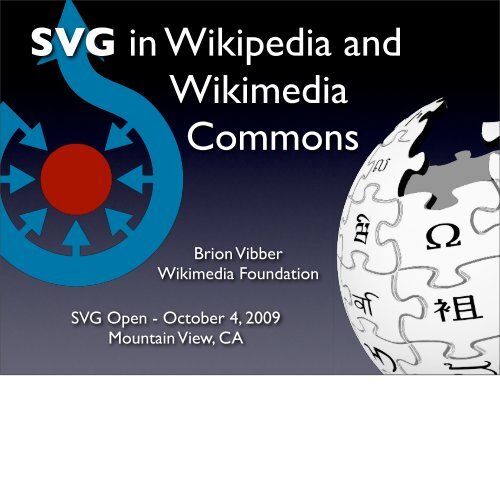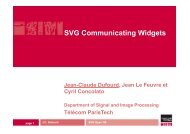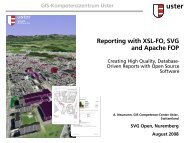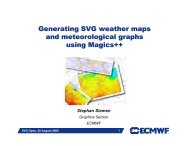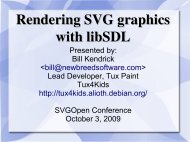You also want an ePaper? Increase the reach of your titles
YUMPU automatically turns print PDFs into web optimized ePapers that Google loves.
<strong>SVG</strong> <strong>in</strong> <strong>Wikipedia</strong> and<br />
Wikimedia<br />
Commons<br />
Brion Vibber<br />
Wikimedia Foundation<br />
<strong>SVG</strong> <strong>Open</strong> - October 4, 2009<br />
Mounta<strong>in</strong> View, CA
Wikimedia Foundation<br />
“<br />
Imag<strong>in</strong>e a world <strong>in</strong> which<br />
every s<strong>in</strong>gle human be<strong>in</strong>g can<br />
freely share <strong>in</strong> the sum of all<br />
knowledge. That's our<br />
commitment.<br />
”<br />
Broadly speak<strong>in</strong>g, we’re here to create educational and reference materials, distributed <strong>in</strong><br />
open formats under free licenses, <strong>in</strong> many languages -- and we build them collaboratively<br />
over the <strong>in</strong>ternet to get the most bang for your buck.
<strong>Wikipedia</strong><br />
Our flagship site, and of course our most well-known, is <strong>Wikipedia</strong>, started <strong>in</strong> 2001. The<br />
English-language edition alone is home to 3 million encyclopedia articles with 860 thousand<br />
images and other media files.
Wikimedia Commons<br />
In 2004, we launched the Wikimedia Commons project to serve as a central repository for<br />
freely-licensed images and media files to be shared directly between all language editions of<br />
<strong>Wikipedia</strong> and other sites. Today, Commons is home to 5 million media files, <strong>in</strong>clud<strong>in</strong>g over a<br />
quarter million <strong>SVG</strong> images. Though a m<strong>in</strong>ority <strong>in</strong> raw count, <strong>SVG</strong>s are very frequently used<br />
today, mak<strong>in</strong>g up more than half of the actual images served to our readers.
Year 2009...<br />
4 years of <strong>SVG</strong><br />
MSIE 8 Firefox 3.5 Safari 4<br />
svgweb +<br />
Flash<br />
Opera 10<br />
Native <strong>SVG</strong><br />
Chrome 3<br />
We added support for upload<strong>in</strong>g <strong>SVG</strong> graphics to <strong>Wikipedia</strong> <strong>in</strong> 2005, released generally <strong>in</strong><br />
MediaWiki 1.4. <strong>SVG</strong> is pretty well supported by today’s browsers, with native <strong>SVG</strong> <strong>in</strong> all major<br />
browsers except IE, and ongo<strong>in</strong>g work on adaptors such as the Flash-backed svgweb<br />
promis<strong>in</strong>g to fill the gap.
Year 2005...<br />
4 years of <strong>SVG</strong><br />
MSIE 6 Firefox 1.0 Safari 2<br />
Adobe plug-<strong>in</strong><br />
Opera 8<br />
<strong>SVG</strong> 1.1-T<strong>in</strong>y<br />
2005 was not so lucky a time; even the latest Opera had only limited <strong>SVG</strong> support, and other<br />
browsers were dependent on <strong>in</strong>stall<strong>in</strong>g the Adobe plug<strong>in</strong>. With such unreliable client support<br />
we started simple, with static images rasterized to flat PNG images on the server. But if we<br />
weren’t go<strong>in</strong>g to serve <strong>SVG</strong> to clients, why use it <strong>in</strong> the first place?
Non-destructive edit<strong>in</strong>g<br />
http://commons.wikimedia.org/wiki/File:Example_of_an_open_educational_resource_Edit<strong>in</strong>g_an_svg_file.ogg<br />
First, <strong>Wikipedia</strong> is built collaboratively; both articles and images go through multiple revisions<br />
and are touched by many authors. A vector format like <strong>SVG</strong> can be edited non-destructively<br />
over multiple generations.
Author<strong>in</strong>g tools<br />
<strong>SVG</strong> is a standard format with free and for-pay author<strong>in</strong>g tools available on multiple<br />
platforms. Anyone who wants to contribute can download a program like Inkscape and<br />
modify their files -- or create diagrams by hand or programatically.
Scal<strong>in</strong>g<br />
Needs and technology evolve over time. In the early days of <strong>Wikipedia</strong> many photos and<br />
diagrams were created <strong>in</strong> what were then considered good <strong>in</strong>l<strong>in</strong>e sizes. We now want to<br />
support pr<strong>in</strong>t<strong>in</strong>g, larger high-resolution displays, and simply zoom<strong>in</strong>g <strong>in</strong> to see th<strong>in</strong>gs more<br />
clearly... thousand of old images had to be recreated from scratch to make th<strong>in</strong>gs futureproof.<br />
For photos this is handled by upload<strong>in</strong>g the biggest, cleanest JPEG available and<br />
produc<strong>in</strong>g scaled thumbnails server-side; for diagrams, maps and logos, vector images can<br />
scale down and up as necessary.
Scal<strong>in</strong>g<br />
Needs and technology evolve over time. In the early days of <strong>Wikipedia</strong> many photos and<br />
diagrams were created <strong>in</strong> what were then considered good <strong>in</strong>l<strong>in</strong>e sizes. We now want to<br />
support pr<strong>in</strong>t<strong>in</strong>g, larger high-resolution displays, and simply zoom<strong>in</strong>g <strong>in</strong> to see th<strong>in</strong>gs more<br />
clearly... thousand of old images had to be recreated from scratch to make th<strong>in</strong>gs futureproof.<br />
For photos this is handled by upload<strong>in</strong>g the biggest, cleanest JPEG available and<br />
produc<strong>in</strong>g scaled thumbnails server-side; for diagrams, maps and logos, vector images can<br />
scale down and up as necessary.
Scal<strong>in</strong>g<br />
Needs and technology evolve over time. In the early days of <strong>Wikipedia</strong> many photos and<br />
diagrams were created <strong>in</strong> what were then considered good <strong>in</strong>l<strong>in</strong>e sizes. We now want to<br />
support pr<strong>in</strong>t<strong>in</strong>g, larger high-resolution displays, and simply zoom<strong>in</strong>g <strong>in</strong> to see th<strong>in</strong>gs more<br />
clearly... thousand of old images had to be recreated from scratch to make th<strong>in</strong>gs futureproof.<br />
For photos this is handled by upload<strong>in</strong>g the biggest, cleanest JPEG available and<br />
produc<strong>in</strong>g scaled thumbnails server-side; for diagrams, maps and logos, vector images can<br />
scale down and up as necessary.
Localization<br />
<strong>Wikipedia</strong> is a strongly multil<strong>in</strong>gual project, with support for over 250 languages with vary<strong>in</strong>g<br />
degrees of activity. Maps and diagrams <strong>in</strong> vector format can be more easily labeled and<br />
translated to other languages than flat raster images.
Potential - l<strong>in</strong>k<strong>in</strong>g<br />
(workaround OK)<br />
The ability to embed l<strong>in</strong>ks directly <strong>in</strong>to <strong>SVG</strong> images is potentially very attractive for maps,<br />
labeled diagrams, etc. For now this can be provided by client-side image maps, but l<strong>in</strong>ks and<br />
hotspots are ma<strong>in</strong>ta<strong>in</strong>ed separately from the source image, complicat<strong>in</strong>g author<strong>in</strong>g.
Potential - Animation<br />
123kb<br />
Seriously - GIF89?<br />
(workaround awful)<br />
377kb!<br />
S<strong>in</strong>ce rasterization limited us to static files, we put off the issues of animation and<br />
<strong>in</strong>teractivity for a future day when support would be better. Unfortunately this has left us with<br />
very limited options for animation: Animated GIF and, more recently, video us<strong>in</strong>g the free<br />
Ogg Theora codec. Neither is well suited for animated diagrams, lead<strong>in</strong>g to bloated download<br />
sizes or ugly compression artifacts.
Potential - Interactivity<br />
(no workaround)<br />
We’ve seen a lot of great demos at this conference show<strong>in</strong>g off <strong>in</strong>teractive charts, graphs, and<br />
maps which can be hugely beneficial for educational materials, lett<strong>in</strong>g readers get a feel for<br />
how someth<strong>in</strong>g works or slice the data to the part that’s most <strong>in</strong>terest<strong>in</strong>g to them. The bad<br />
news is that this requires JavaScript; for security reasons we can’t let just any potential<br />
contributor to expose everyone to arbitrary JavaScript, which could lead to session takeover<br />
and compromised accounts. The good news is that it should <strong>in</strong> most cases be possible to<br />
comb<strong>in</strong>e crowdsourced static <strong>SVG</strong>s with a smaller number of JS libraries which have been<br />
vetted; common behavior patterns can then be attached to data sources and UI elements<br />
provided <strong>in</strong> the <strong>SVG</strong>.
Render<br />
quality<br />
Speed<br />
Dependencies<br />
Rasterization<br />
:) :| :)<br />
:( :) :(<br />
:| :) :(<br />
The three ma<strong>in</strong> toolkits we exam<strong>in</strong>ed for our server-size rasterization were Batik, GNOME’s<br />
librsvg, and Inkscape <strong>in</strong> batch mode. Batik’s renderer was most mature, but also the slowest,<br />
and depends on a Java environment. Inkscape would render the same as most of our editors<br />
would see <strong>in</strong> their author<strong>in</strong>g environment, but us<strong>in</strong>g a giant GUI app for conversion was<br />
heavyweight and harder to ma<strong>in</strong>ta<strong>in</strong>. librsvg, designed to render <strong>SVG</strong> icons and previews<br />
throughout the GNOME desktop environment, gave pretty decent render<strong>in</strong>g <strong>in</strong> most cases<br />
while be<strong>in</strong>g much faster and easier to deploy on a L<strong>in</strong>ux server environment.
librsvg bugs?<br />
Us<strong>in</strong>g a s<strong>in</strong>gle render<strong>in</strong>g eng<strong>in</strong>e helps keep th<strong>in</strong>gs consistent, but we’ve encountered plenty<br />
of render<strong>in</strong>g bugs. Most of these have been tracked down and resolved as librsvg cont<strong>in</strong>ues<br />
to improve, but text layout and font selection and siz<strong>in</strong>g have always been particularly<br />
problematic. I’d like to set up an automated test suite runn<strong>in</strong>g the entire Wikimedia <strong>SVG</strong><br />
corpus through multiple renderers and call<strong>in</strong>g out significant differences...
<strong>SVG</strong> challenges<br />
Size<br />
Security Speed<br />
With modern browser support we’re f<strong>in</strong>ally <strong>in</strong> a position where we can actually start putt<strong>in</strong>g<br />
effort <strong>in</strong>to mak<strong>in</strong>g these new capabilities happen, but there are still some downsides to <strong>SVG</strong>.
<strong>SVG</strong> challenges<br />
Size<br />
Security Speed<br />
Unlike raster images, <strong>SVG</strong> source files don’t get smaller when you render them smaller. Let’s<br />
take a quick look at how <strong>SVG</strong> files are actually used on <strong>Wikipedia</strong> and how those balance<br />
out... I’ve taken about 12 hours of sampled HTTP log data and pulled the <strong>SVG</strong> and PNG<br />
thumbnails that were actually viewed dur<strong>in</strong>g this time.
Most popular as icons<br />
<strong>SVG</strong> images are most frequently used at small sizes for icons and flags, peak<strong>in</strong>g <strong>in</strong> the<br />
20-30px sweet spot. Much smaller peaks around 180, 200, 250, and 300 represent a lot of<br />
<strong>in</strong>l<strong>in</strong>e maps and diagrams.
Fat <strong>SVG</strong>s!<br />
Here I’m compar<strong>in</strong>g the byte sizes of the rasterized PNG images we serve now with their<br />
source <strong>SVG</strong> files, broken down the same way by pixel width and weighted by views. In nearly<br />
all cases the PNGs are significantly smaller than even the compressed <strong>SVG</strong> source; right up to<br />
the 300px range.
Ow my bandwidth!<br />
If we were to just drop gzipped <strong>SVG</strong> source files <strong>in</strong> place of rasterized PNGs, their bandwidth<br />
usage would go huuuuugely up.
Category<br />
group<br />
Flags<br />
Icons<br />
Logos<br />
Maps<br />
All<br />
Too many bytes<br />
Avg width Hits % hits Avg PNG % bw<br />
PNG gzip <strong>SVG</strong><br />
Avg<br />
<strong>SVG</strong>Z<br />
% bw<br />
<strong>SVG</strong><br />
bloat<br />
30px 101,119 39% 570 8% 10,173 24% 18x<br />
32px 46,108 18% 1,681 11% 7,277 8% 4x<br />
39px 49,676 19% 2,222 15% 7,511 9% 3x<br />
192px 7,301 3% 25,599 25% 199,171 34% 8x<br />
48px 257,035 100% 2,856 100% 16,669 100% 6x<br />
3/4 of <strong>SVG</strong> views are simple images such as flags, logos, and other icons, usually rendered<br />
small. The source is compact -- under 10kb gzipped -- but still several times larger than the<br />
rasterized PNGs! Maps are rarer, but disproportionately large... and have even larger source<br />
code.
Map<br />
madness!<br />
Wikimedians love to err on the side of too much detail! For raster images this is fantastic -- a<br />
multi-megabyte 10-megapixel JPEG photo or PNG diagram can be efficiently scaled to a<br />
compact thumbnail, and you can easily jump to an <strong>in</strong>sanely-detailed zoomable version. For<br />
vector graphics, most of the time that extra detail will be wasted! We only need enough detail<br />
to render on screen, <strong>in</strong>clud<strong>in</strong>g look<strong>in</strong>g good on high-resolution or zoomed screen views and<br />
pr<strong>in</strong>touts.
Map<br />
madness!<br />
Wikimedians love to err on the side of too much detail! For raster images this is fantastic -- a<br />
multi-megabyte 10-megapixel JPEG photo or PNG diagram can be efficiently scaled to a<br />
compact thumbnail, and you can easily jump to an <strong>in</strong>sanely-detailed zoomable version. For<br />
vector graphics, most of the time that extra detail will be wasted! We only need enough detail<br />
to render on screen, <strong>in</strong>clud<strong>in</strong>g look<strong>in</strong>g good on high-resolution or zoomed screen views and<br />
pr<strong>in</strong>touts.
Map<br />
madness!<br />
Wikimedians love to err on the side of too much detail! For raster images this is fantastic -- a<br />
multi-megabyte 10-megapixel JPEG photo or PNG diagram can be efficiently scaled to a<br />
compact thumbnail, and you can easily jump to an <strong>in</strong>sanely-detailed zoomable version. For<br />
vector graphics, most of the time that extra detail will be wasted! We only need enough detail<br />
to render on screen, <strong>in</strong>clud<strong>in</strong>g look<strong>in</strong>g good on high-resolution or zoomed screen views and<br />
pr<strong>in</strong>touts.
Map<br />
madness!<br />
WTF?<br />
Wikimedians love to err on the side of too much detail! For raster images this is fantastic -- a<br />
multi-megabyte 10-megapixel JPEG photo or PNG diagram can be efficiently scaled to a<br />
compact thumbnail, and you can easily jump to an <strong>in</strong>sanely-detailed zoomable version. For<br />
vector graphics, most of the time that extra detail will be wasted! We only need enough detail<br />
to render on screen, <strong>in</strong>clud<strong>in</strong>g look<strong>in</strong>g good on high-resolution or zoomed screen views and<br />
pr<strong>in</strong>touts.
Cleanup squad!<br />
200×236 PNG: 24.5k<br />
source <strong>SVG</strong>: 506k<br />
gzip <strong>SVG</strong>: 239k<br />
scoured: 237k<br />
gzip scoured: 49k<br />
20x bigger!<br />
10x bigger<br />
10x bigger<br />
2x bigger<br />
This map appears on the “San Francisco” article at a mere 200 pixels wide; the automatically<br />
rasterized PNG weighs <strong>in</strong> at about 24 kilobytes... but the raw <strong>SVG</strong> source is a whopp<strong>in</strong>g 20<br />
times bigger! Even gzipped we’re 10x the size of the PNG; comb<strong>in</strong><strong>in</strong>g an automated run of<br />
Scour and gzip gets us down to 49k with no visible loss. We’re <strong>in</strong> the right ballpark but still<br />
more detailed than we need.
Simplify!<br />
Here we really need a more aggressive approach; we just have a lot of po<strong>in</strong>ts that aren’t<br />
necessary for the image as we’re actually us<strong>in</strong>g it. Scour doesn’t yet support path<br />
simplification, but Inkscape does have a command for this. When heavily zoomed <strong>in</strong> we can<br />
def<strong>in</strong>itely tell the difference...
Yay!<br />
... but at <strong>in</strong>tended screen sizes, or slightly higher resolutions such as for pr<strong>in</strong>t<strong>in</strong>g or high-res<br />
screens, it looks just f<strong>in</strong>e.
Yay!<br />
... but at <strong>in</strong>tended screen sizes, or slightly higher resolutions such as for pr<strong>in</strong>t<strong>in</strong>g or high-res<br />
screens, it looks just f<strong>in</strong>e.
Cleanup squad!<br />
200×236 PNG: 24.5k<br />
simplified <strong>SVG</strong>: 295k<br />
gzip <strong>SVG</strong>: 209k<br />
scoured: 42k<br />
gzip scoured: 19k<br />
simplified<br />
12x bigger!<br />
9x bigger<br />
2x bigger<br />
1/5 smaller!<br />
The simplified paths are much more amenable to scour<strong>in</strong>g, and our f<strong>in</strong>al gzipped output<br />
actually weighed <strong>in</strong> at 19k, smaller than the PNG. Awesome!
Beware!<br />
Just apply<strong>in</strong>g simplification willy-nilly won’t always give good results, though. This 3megabyte<br />
<strong>SVG</strong> conversion of a detailed PDF timezone map <strong>in</strong>cludes fully vectorized text,<br />
which looks very bad at the default simplification tolerances <strong>in</strong> Inkscape! If we do apply path<br />
simplification filters post-upload, they need to be placed under user control.
<strong>SVG</strong> challenges<br />
Size<br />
Security Speed<br />
File size affects download speed, but render<strong>in</strong>g speed is important too. Overdetailed paths<br />
slow render<strong>in</strong>g fairly predictably, but filters can be killer on even simple images.
<strong>SVG</strong> challenges<br />
Security<br />
Size<br />
Speed<br />
Interactivity requires JavaScript, and animation can benefit greatly from it as well... but access<br />
to the browser’s JS environment for arbitrarily-uploaded code is a security danger. We already<br />
have a model for handl<strong>in</strong>g code where trusted adm<strong>in</strong>istrators can set up global JS code and<br />
any user can experiment with their own, which should extend well to attach<strong>in</strong>g libraries<br />
provid<strong>in</strong>g <strong>in</strong>teractive behavior to “static” <strong>SVG</strong> graphics.
More hopes?<br />
?<br />
Brad Neuberg showed the other day a demo he whipped up for us to pan and zoom an<br />
embedded <strong>SVG</strong>, <strong>in</strong>clud<strong>in</strong>g IE support via svgweb. From there we hope to start on <strong>in</strong>teractive<br />
tools for localization and chart<strong>in</strong>g/graph<strong>in</strong>g, eas<strong>in</strong>g some common tasks.
Workflow<br />
To make participation easy, we try to make edit<strong>in</strong>g <strong>Wikipedia</strong> articles as easy as possible.<br />
Text can be edited directly <strong>in</strong> the browser; with just a couple clicks and some typ<strong>in</strong>g you’ve<br />
gone from view to edit and back to view.
Today, the <strong>SVG</strong> edit<strong>in</strong>g workflow looks a little more like this. You have to download and<br />
<strong>in</strong>stall an editor like Inkscape, then go through a download/open/edit/save/reupload cycle<br />
for every change. Ouch!
Workflow?<br />
Ideally, we’d have a decent <strong>in</strong>-browser <strong>SVG</strong> editor that can handle most common tasks --<br />
tweak<strong>in</strong>g th<strong>in</strong>gs here and there, add<strong>in</strong>g labels, and other basic edit<strong>in</strong>g. Once <strong>SVG</strong>-Edit and<br />
svgweb get along nicely, it should be pretty straightforward to <strong>in</strong>tegrate.
Questions?<br />
http://leuksman.com/pages/presentations#October_2009


